Shea Sc 2002 The Practical Art of Suicide Assessment Hoboken Nj John Wiley and Sons Ebook
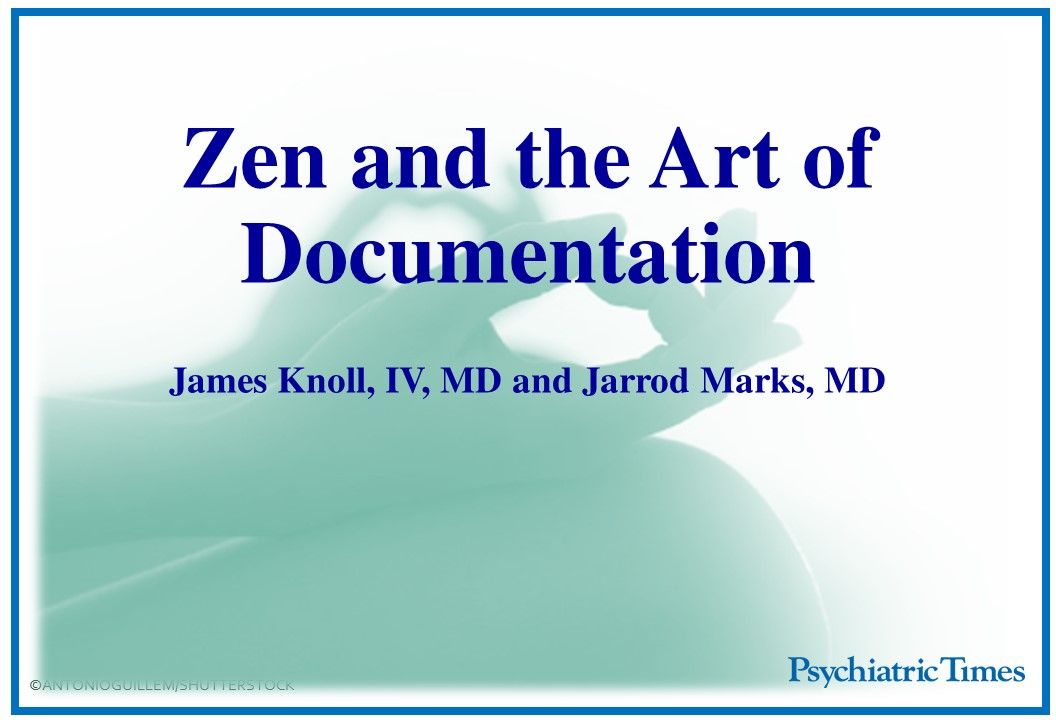
-"Use merely that which works and take it from any place yous can find it."1
̶Bruce Lee
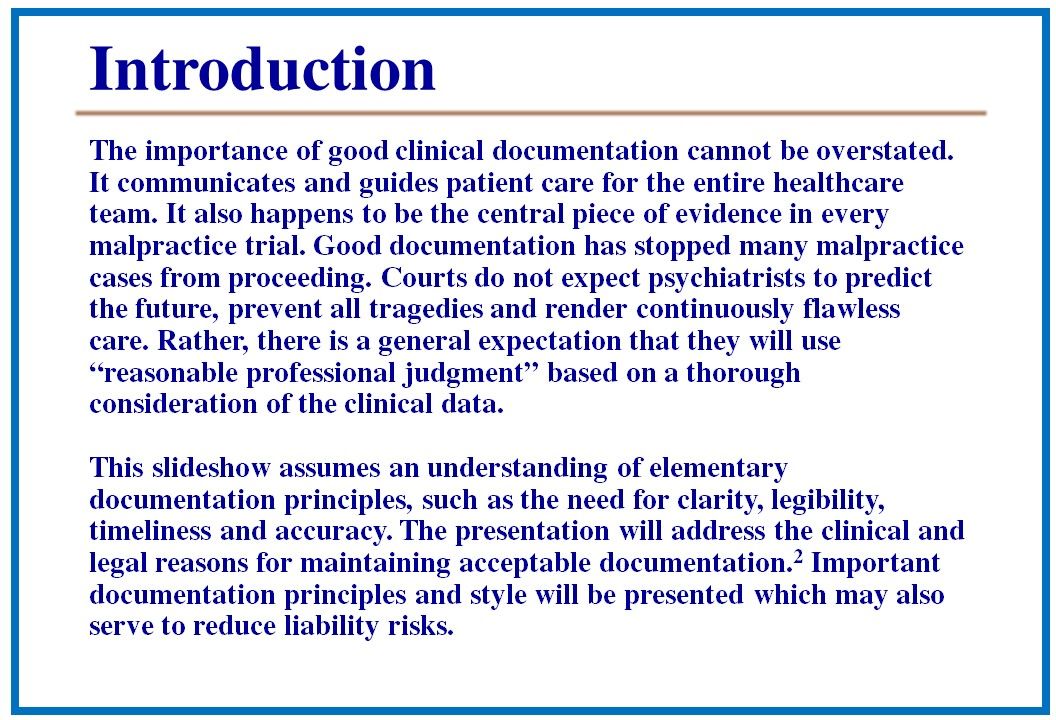
The importance of good clinical documentation cannot be overstated. It communicates and guides patient care for the entire healthcare squad. It also happens to be the cardinal slice of evidence in every malpractice trial. Proficient documentation has stopped many malpractice cases from proceeding. Courts practice non wait psychiatrists to predict the time to come, preclude all tragedies and render continuously flawless care. Rather, there is a general expectation that they will use "reasonable professional judgment" based on a thorough consideration of the clinical data.
This slideshow assumes an understanding of simple documentation principles, such as the need for clarity, legibility, timeliness and accuracy. The presentation will address the clinical and legal reasons for maintaining acceptable documentation.2 Important documentation principles and manner will be presented which may also serve to reduce liability risks.
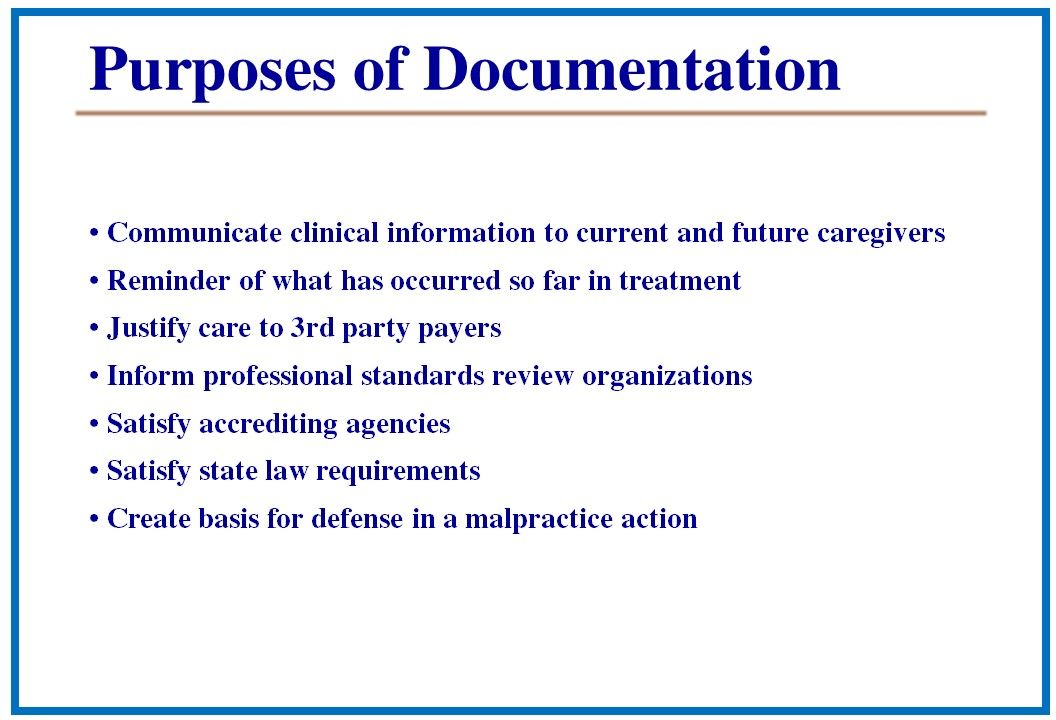
• Communicate clinical information to electric current and future caregivers
• Reminder of what has occurred so far in treatment
• Justify care to third political party payers
• Inform professional person standards review organizations
• Satisfy accrediting agencies
• Satisfy state law requirements
• Create basis for defense in a malpractice action
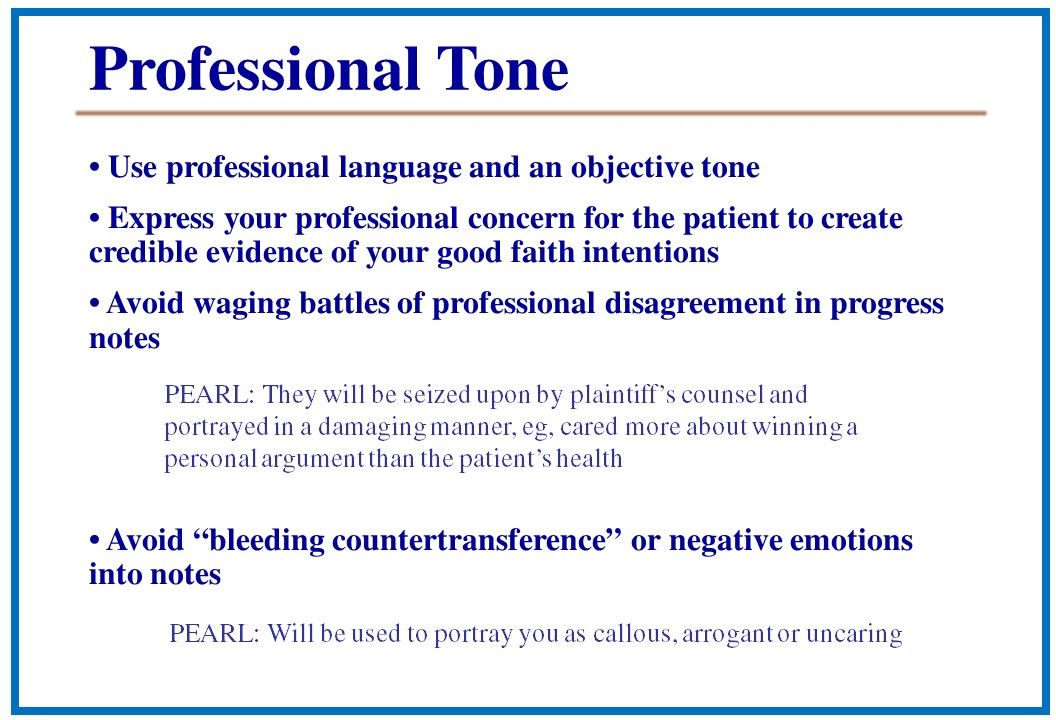
• Employ professional person language and an objective tone
• Express your professional concern for the patient to create apparent evidence of your good organized religion intentions
• Avoid waging battles of professional disagreement in progress notes

• Document in such a manner that you are fully prepared to have the annotation exist an exhibit in court
• In the event of a lawsuit, this is precisely what will occur
• In many cases, the notes are enlarged and printed out on poster boards to prove a jury
• Documentation will make a amend impression if it is clear, professional person and free of gratuitous comments

• Sooner is amend
• Credible documentation is done just after service is rendered
• Charting completed after an adverse result is vulnerable to accusations of fabrication
• Tardily documentation will exist portrayed every bit self-serving by plaintiff's counsel

• Some take suggested more is meliorate
• Efficient use of time requires a residual in terms of quantity
• Strive for quality over quantity – smarter, non longer
PEARL: Documentation should exist succinct and thoughtful, yet non excessive
• Should contain objective findings, patients' statements, clinical judgments, and decision-making rationale
• Information technology is a myth that liability is reduced past no or petty documentation
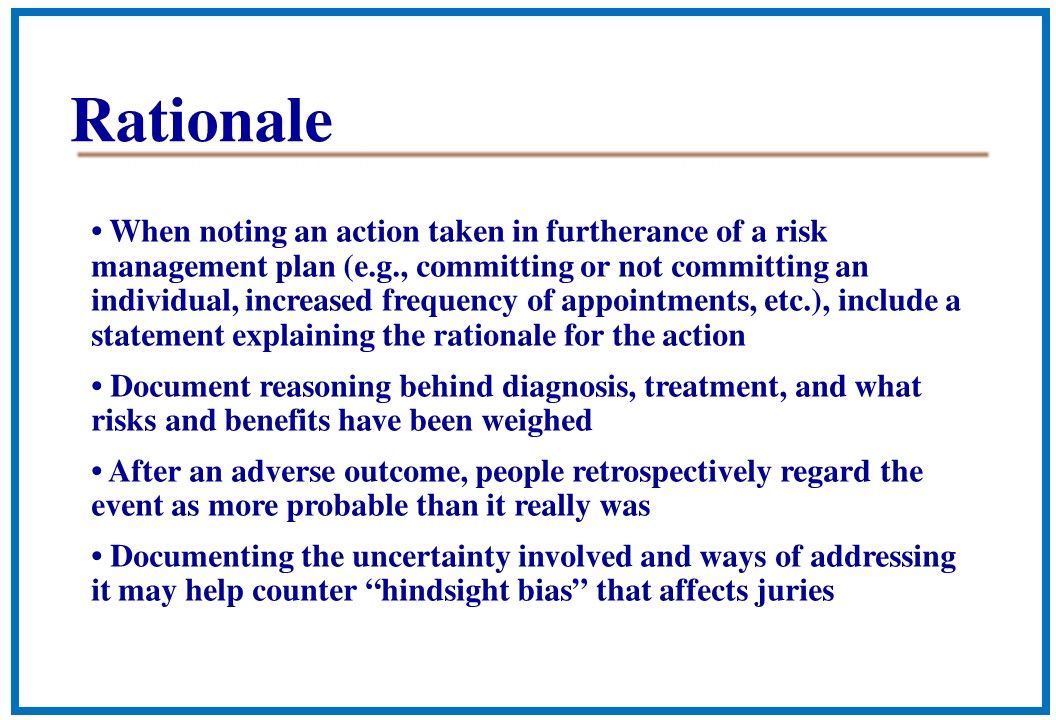
• When noting an action taken in furtherance of a risk management program (eg, committing or not committing an individual, increased frequency of appointments, etc.), include a statement explaining the rationale for the action
• Document reasoning behind diagnosis, treatment, and what risks and benefits have been weighed
• After an adverse outcome, people retrospectively regard the event as more probable than it really was
• Documenting the uncertainty involved and means of addressing it may help counter "hindsight bias" that affects juries
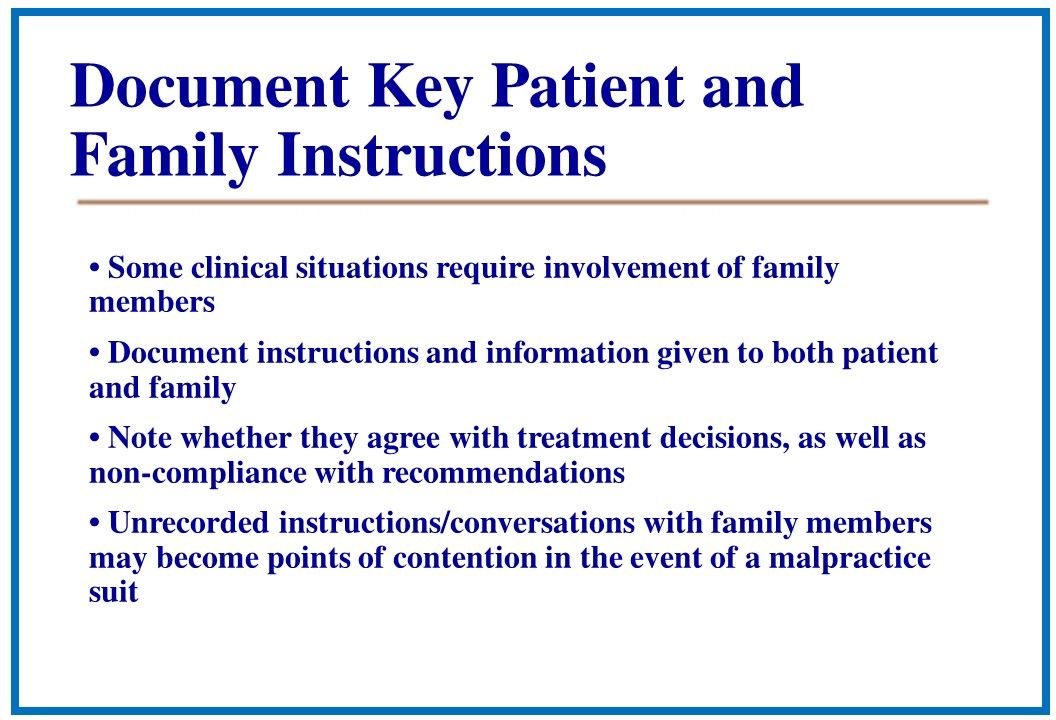
• Some clinical situations require interest of family members
• Document instructions and information given to both patient and family
• Note whether they agree with treatment decisions, as well as not-compliance with recommendations
• Unrecorded instructions/conversations with family members may become points of contention in the event of a malpractice accommodate
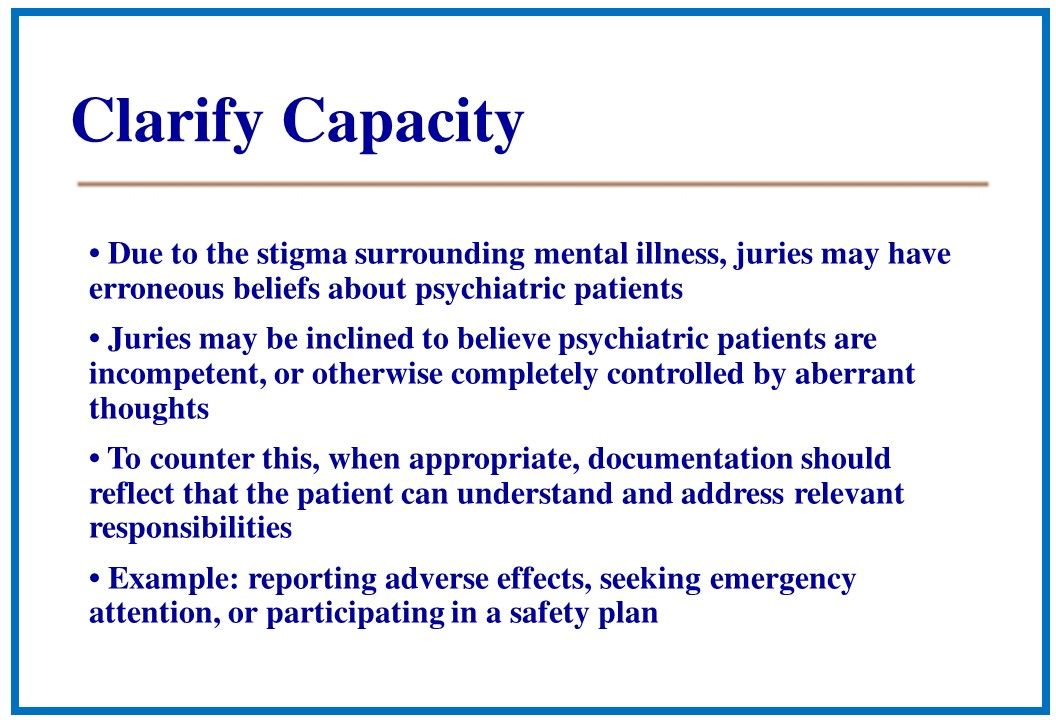
• Some clinical situations require involvement of family members
• Document instructions and information given to both patient and family
• Notation whether they agree with treatment decisions, as well equally not-compliance with recommendations
• Unrecorded instructions/conversations with family members may get points of contention in the effect of a malpractice suit• Due to the stigma surrounding mental affliction, juries may accept erroneous beliefs about psychiatric patients
• Juries may exist inclined to believe psychiatric patients are incompetent, or otherwise completely controlled by aberrant thoughts
• To counter this, when appropriate, documentation should reverberate that the patient can understand and address relevant responsibilities
• Example: reporting agin effects, seeking emergency attention, or participating in a safety program

• Documenting verbatim statements from a patient, such as "I've never considered suicide," tin can speedily convey key data y'all considered when making a decision
• In malpractice trials, patient quotes are powerful prove, and must be taken at face value unless proven to be unreliable
• 1 important exception has to do with inconsistency of clinical information
• If a patient "has a big number or gamble factors nevertheless denies any thoughts about suicide, such an inconsistency betwixt risk factors and reported ideation may signal that the client is hiding information."4
• In such circumstances, if the patient is quoted as denying any suicidal ideas, it is important to document the reasoning behind why the patient'due south words are credible
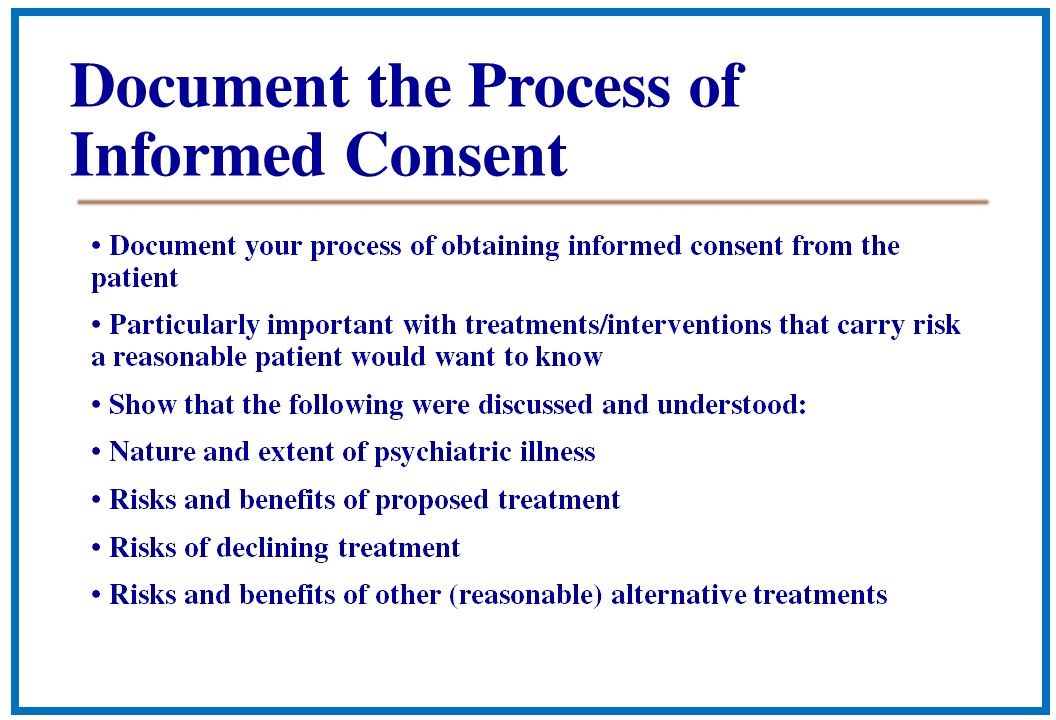
• Document your procedure of obtaining informed consent from the patient
• Peculiarly important with treatments/interventions that acquit risk a reasonable patient would want to know
• Show that the post-obit were discussed and understood:
• Nature and extent of psychiatric illness
• Risks and benefits of proposed treatment
• Risks of declining treatment
• Risks and benefits of other (reasonable) culling treatments

• Demonstrate you are enlightened of relevant take a chance factors
• Ideally, include some form of analysis of risk factors, and general estimate of overall risk level (depression, moderate, or high)
• Should be followed by handling programme that directly addresses relevant modifiable run a risk factors, and rationale for choosing or rejecting options
• When at a clinical fork in the route where there are 2 plausible paths, choose the safest path

• This tip comes from an experienced psychiatric malpractice defence force attorney.five When asked what documentation trouble makes information technology nearly difficult to successfully defend psychiatrists, he answered: "When they leave loose ends in their documentation."
• What he meant was – if a loftier-hazard issue is raised in documentation, never leave information technology unaddressed
• Be sure to document implementation of a reasonable intervention targeting the loftier-risk issue in the handling plan section
• The higher the risk involved, the more diligent the documentation must be regarding how the programme will address the risk
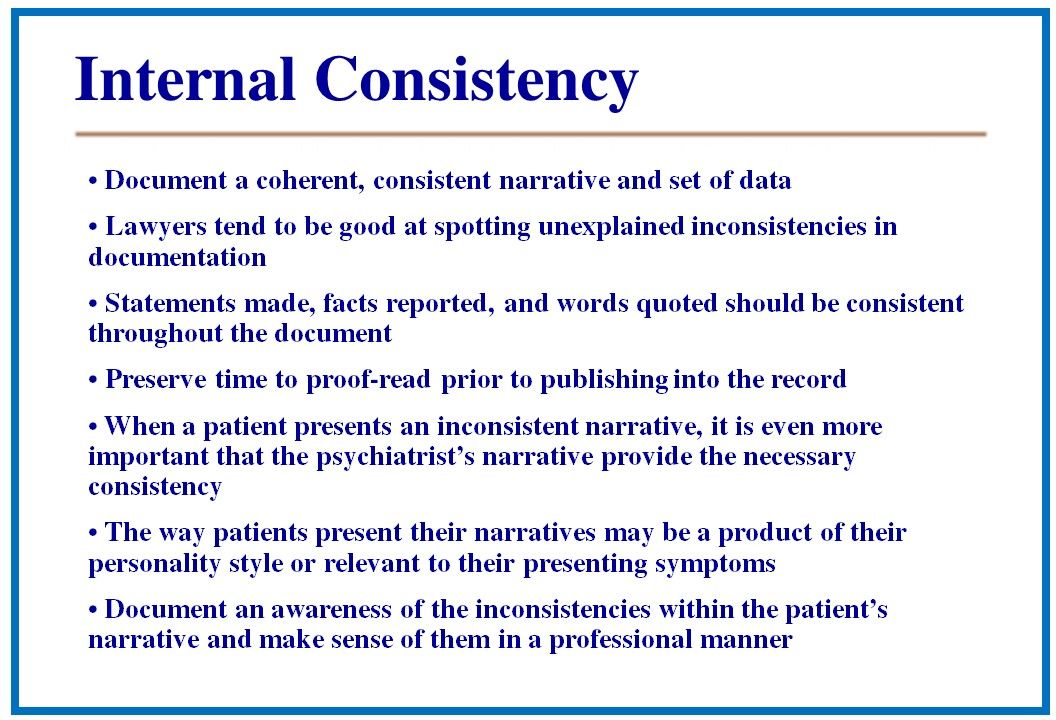
• Certificate a coherent, consistent narrative and gear up of data
• Lawyers tend to exist skilful at spotting unexplained inconsistencies in documentation
• Statements fabricated, facts reported, and words quoted should exist consistent throughout the document
• Preserve time to proof-read prior to publishing into the tape
• When a patient presents an inconsistent narrative, it is even more than important that the psychiatrist's narrative provide the necessary consistency
• The way patients present their narratives may exist a product of their personality style or relevant to their presenting symptoms
• Document an sensation of the inconsistencies within the patient's narrative and brand sense of them in a professional way

• In difficult cases, seek consultation if possible
• It will exist difficult for plaintiff's chaser to prove that "no reasonably prudent clinician" would have made a decision at issue, when at that place are ii clinicians arriving at the aforementioned conclusion
• Caveat: consultation will be effective only if consultant has been fully informed of the details of case. The bullheaded leading the blind provides no protection
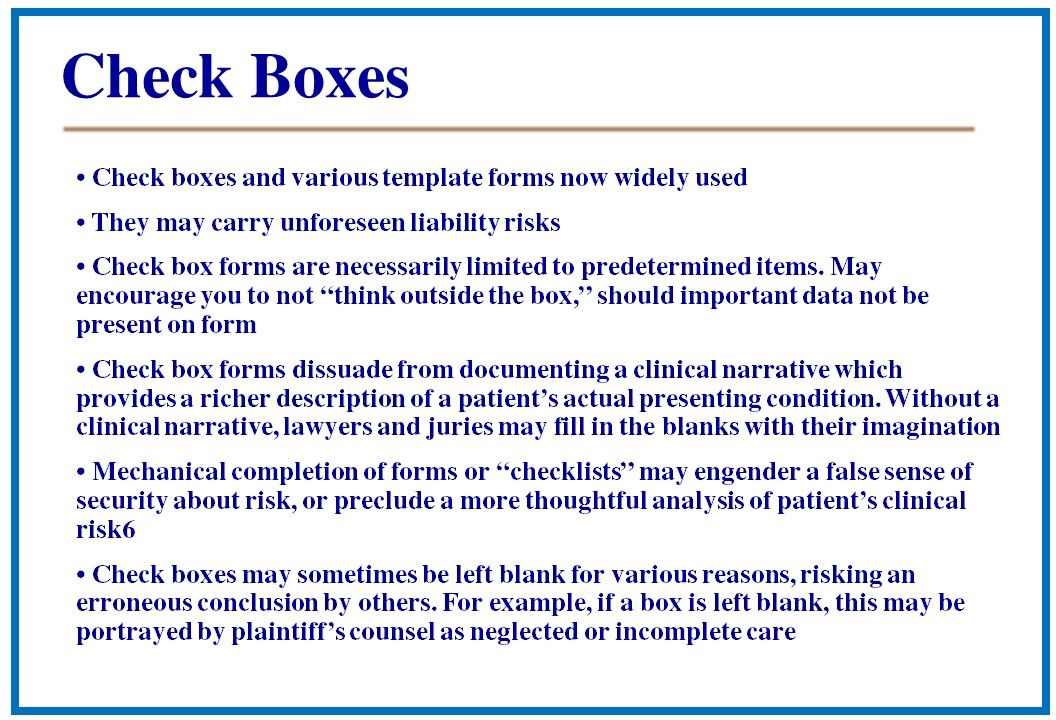
• Check boxes and various template forms at present widely used
• They may carry unforeseen liability risks
• Check box forms are necessarily limited to predetermined items. May encourage you to not "think exterior the box," should important data not be present on course
• Bank check box forms dissuade from documenting a clinical narrative which provides a richer clarification of a patient's actual presenting condition. Without a clinical narrative, lawyers and juries may make full in the blanks with their imagination
• Mechanical completion of forms or "checklists" may engender a false sense of security about risk, or preclude a more thoughtful analysis of patient's clinical chance6
• Check boxes may sometimes exist left bare for various reasons, risking an erroneous decision by others. For example, if a box is left blank, this may be portrayed by plaintiff'south counsel as neglected or incomplete intendance
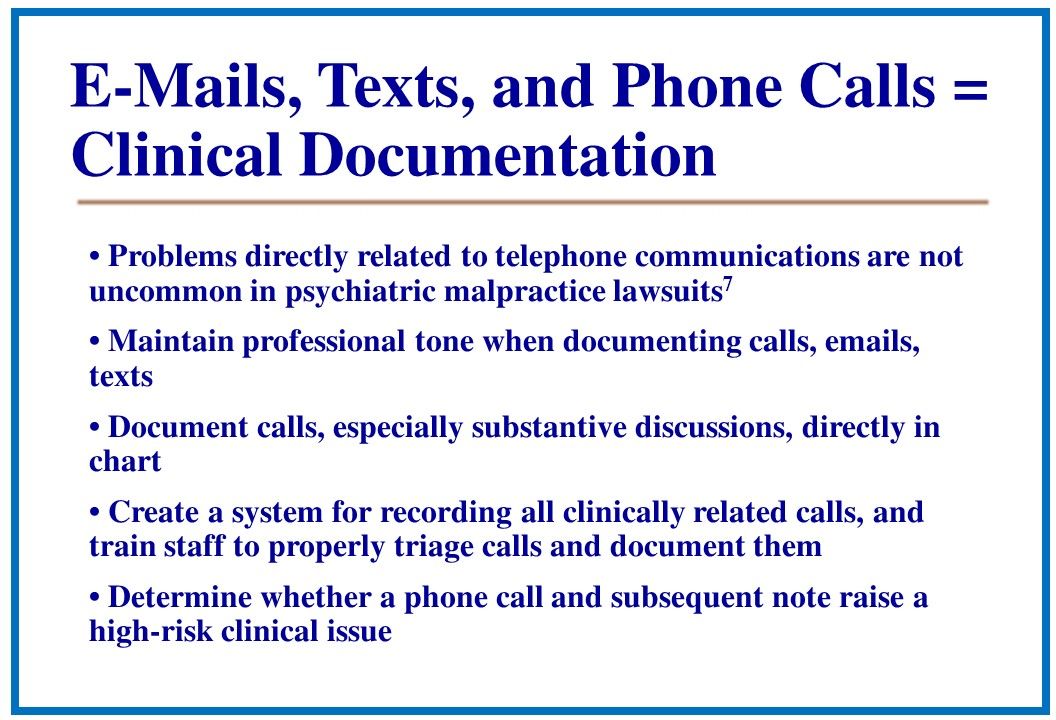
• Issues straight related to telephone communications are non uncommon in psychiatric malpractice lawsuits7
• Maintain professional person tone when documenting calls, emails, texts
• Document calls, especially substantive discussions, directly in chart
• Create a system for recording all clinically related calls, and train staff to properly triage calls and document them
• Determine whether a phone call and subsequent note enhance a high-chance clinical outcome
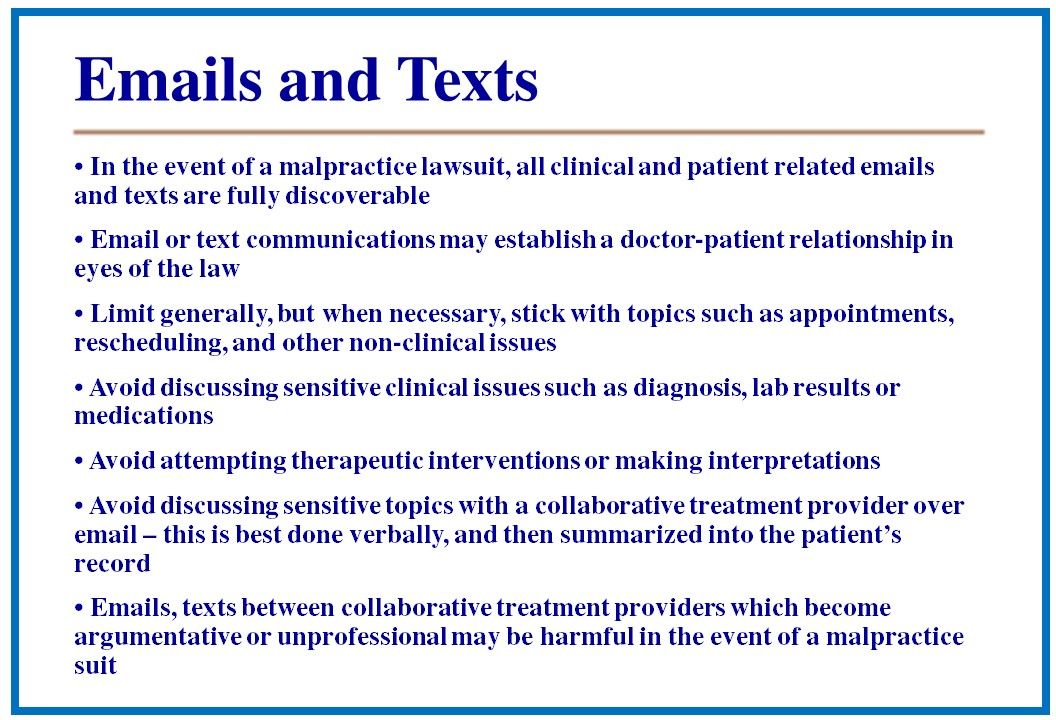
• In the upshot of a malpractice lawsuit, all clinical and patient related emails and texts are fully discoverable
• Email or text communications may plant a doctor-patient relationship in eyes of the law
• Limit generally, just when necessary, stick with topics such every bit appointments, rescheduling, and other non-clinical problems
• Avoid discussing sensitive clinical problems such every bit diagnosis, lab results or medications
• Avoid attempting therapeutic interventions or making interpretations
• Avoid discussing sensitive topics with a collaborative treatment provider over email – this is best done verbally, and then summarized into the patient's record
• Emails, texts between collaborative treatment providers which become argumentative or unprofessional may be harmful in the result of a malpractice adapt
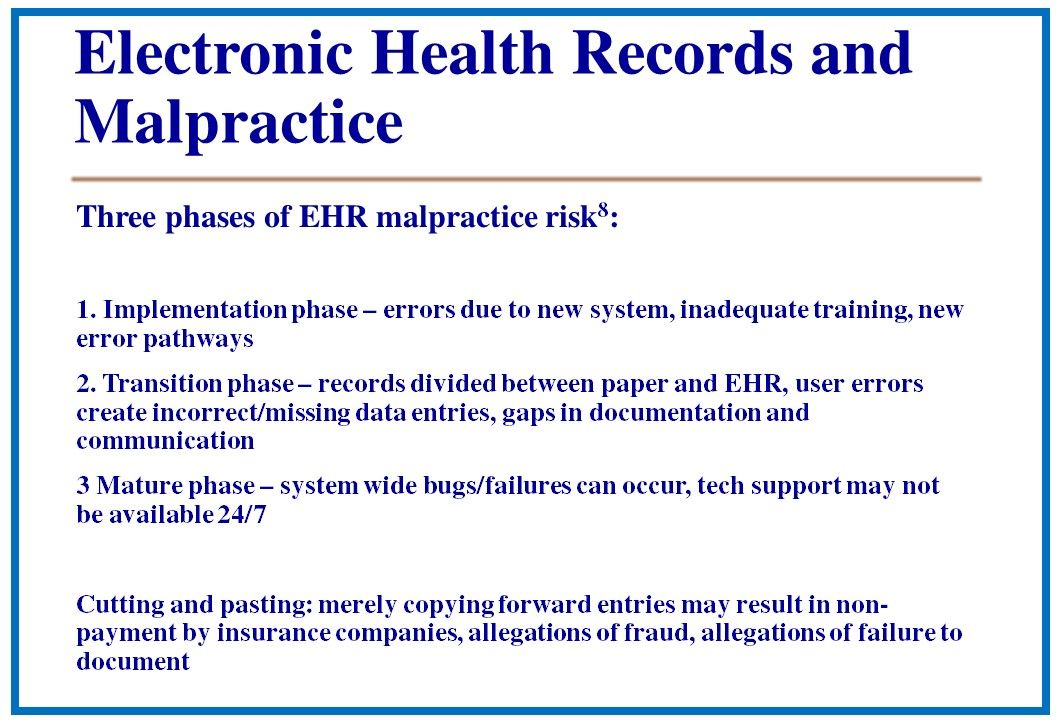
3 phases of EHR malpractice risk8:
ane. Implementation phase – errors due to new organization, inadequate training, new fault pathways
ii. Transition phase – records divided between newspaper and EHR, user errors create incorrect/missing data entries, gaps in documentation and communication
iii Mature phase – system wide bugs/failures can occur, tech support may non be available 24/7
Cutting and pasting: just copying forrard entries may upshot in not-payment by insurance companies, allegations of fraud, allegations of failure to document
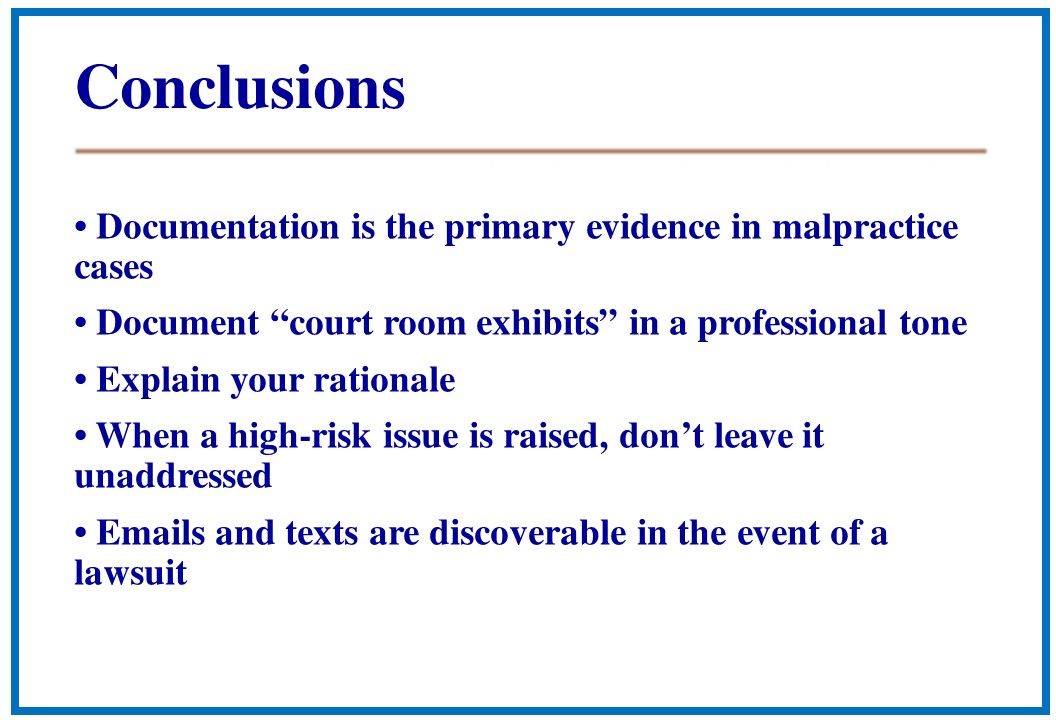
• Documentation is the chief evidence in malpractice cases
• Document "court room exhibits" in a professional tone
• Explain your rationale
• When a high-adventure consequence is raised, don't exit it unaddressed
• Emails and texts are discoverable in the result of a lawsuit
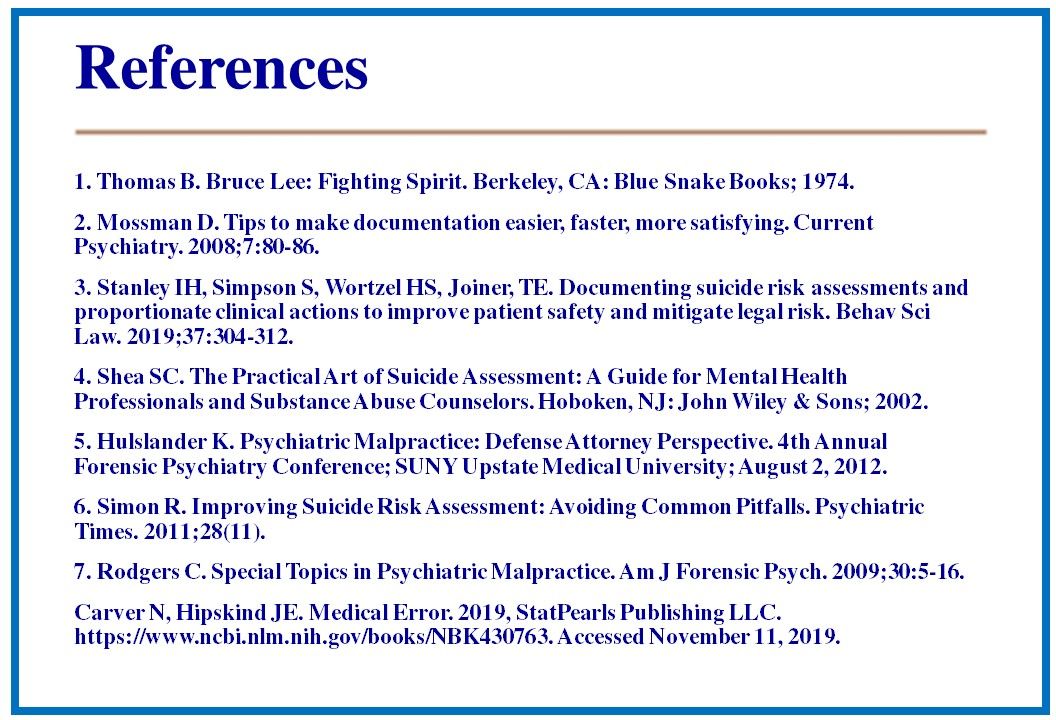
i. Thomas B. Bruce Lee: Fighting Spirit. Berkeley, CA: Bluish Snake Books; 1974.
ii. Mossman D. Tips to make documentation easier, faster, more satisfying. Current Psychiatry. 2008;seven:eighty-86.
3. Stanley IH, Simpson S, Wortzel HS, Joiner, TE. Documenting suicide risk assessments and proportionate clinical deportment to improve patient safety and mitigate legal chance. Behav Sci Law. 2019;37:304-312.
four. Shea SC. The Practical Fine art of Suicide Assessment: A Guide for Mental Health Professionals and Substance Abuse Counselors. Hoboken, NJ: John Wiley & Sons; 2002.
5. Hulslander K. Psychiatric Malpractice: Defense Chaser Perspective. 4th Almanac Forensic Psychiatry Conference; SUNY Upstate Medical University; August 2, 2012.
6. Simon R. Improving Suicide Risk Cess: Avoiding Common Pitfalls. Psychiatric Times. 2011;28(eleven).
7. Rodgers C. Special Topics in Psychiatric Malpractice. Am J Forensic Psych. 2009;30:five-16.
Carver N, Hipskind JE. Medical Fault. 2019, StatPearls Publishing LLC. https://www.ncbi.nlm.nih.gov/books/NBK430763. Accessed November xi, 2019.
Source: https://www.psychiatrictimes.com/view/zen-and-art-documentation
0 Response to "Shea Sc 2002 The Practical Art of Suicide Assessment Hoboken Nj John Wiley and Sons Ebook"
Post a Comment